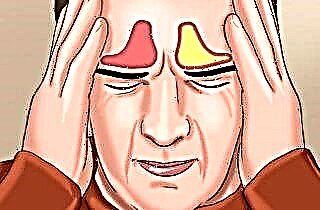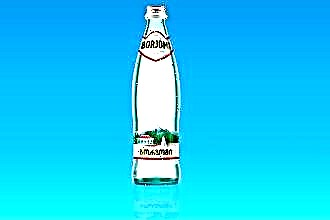With sinusitis, the paranasal sinuses become inflamed. Such an ailment, although it is quite rare in both children and adults, can bring a lot of discomfort as it develops.
Sinusitis is terrible not only with a high probability of relapse, but also with possible complications. It is them that you should beware of and at the first symptoms of the disease, immediately consult a doctor. Timely medical assistance is a guarantee of successful treatment of sinusitis complications.
Symptoms
 The manifestations of this disease vary depending on the form of the disease - acute or chronic. Thus, acute sinusitis is characterized by prolonged rhinitis (runny nose), which does not go away for more than 7 days. The patient has a stuffy nose, a feeling of excess pressure appears in the nasal passages. In most cases, a clear secretion or purulent fluid is abundantly secreted from the nasal cavity.
The manifestations of this disease vary depending on the form of the disease - acute or chronic. Thus, acute sinusitis is characterized by prolonged rhinitis (runny nose), which does not go away for more than 7 days. The patient has a stuffy nose, a feeling of excess pressure appears in the nasal passages. In most cases, a clear secretion or purulent fluid is abundantly secreted from the nasal cavity.
Often, mucus from the paranasal sinuses enters the oropharynx. As a result, there is discomfort in the throat, there is an unpleasant taste in the mouth. Coughing up pus is possible. Severe headaches regularly occur, general weakness and fatigue are noted, even after minor physical exertion.
When the body is intoxicated with the waste products of bacteria, the body temperature often rises to 39 degrees (subfebrile temperature). In addition, lacrimation and increased sensitivity to bright light often accompany the acute form of sinusitis. Irritability, apathy appears, night sleep is disturbed, appetite disappears. In many patients, the acuity of smell is noticeably reduced; after a night's sleep, the cheeks and wings of the nose may swell.
As for chronic sinusitis, in this case, the symptoms will be less pronounced and slightly blurred. For this reason, it is difficult to make an accurate diagnosis, the doctor has to resort to hardware diagnostic methods.
Signs of a chronic form of sinusitis:
- nasal congestion;
- violation of nasal breathing;
- regular discharge from the nostrils;
- sore throat and dry coughing attacks;
- headache;
- the appearance of bad breath.
 Young children can get sinusitis too. As in the chronic form of the disease, the manifestations of the disease are weak. In children, sinusitis develops against the background of an incompletely cured cold, sore throat, flu and any other infectious disease. In some young patients, sinusitis is accompanied by otitis media.
Young children can get sinusitis too. As in the chronic form of the disease, the manifestations of the disease are weak. In children, sinusitis develops against the background of an incompletely cured cold, sore throat, flu and any other infectious disease. In some young patients, sinusitis is accompanied by otitis media.
Due to the blurred clinical picture, when making a diagnosis in children, doctors focus on three key symptoms:
- discharge from the nose of clear or purulent mucus;
- bad breath;
- general weakness of the body and rapid fatigability.
Types and forms of sinusitis
Unlike common rhinitis, as sinusitis progresses, inflammation affects the entire nasal mucosa. Pathogenic changes occur in one of the paranasal sinuses. Depending on the specific location of the inflammation, the following types of sinusitis are distinguished:
- Sinusitis occurs most often and involves the defeat of the maxillary sinuses. At the initial stage of the disease, the mucous membrane thickens, swelling rapidly develops, which blocks the evacuation of mucus from the nasal cavity. It stagnates within the sinus and serves as an excellent breeding ground for pathogens.
- Ethmoiditis is characterized by inflammation of the cells of the ethmoid labyrinth. Usually, this disease is a complication of influenza, acute rhinitis (runny nose) and other infectious ailments. The risk of ethmoiditis increases significantly if a person has too narrow ethmoid sinuses or a deviated nasal septum. This can provoke mucus stagnation with all the ensuing consequences.
 The most severe and dangerous type of sinusitis is frontal sinusitis, in which the inflammatory process is localized within one or two frontal sinuses. As the disease develops, the patient develops pain in the frontal region and above the eyebrows. They can get worse when the head is tilted. As with other types of sinusitis, with frontal sinusitis, the temperature rises, purulent foci appear, and other characteristic symptoms appear.
The most severe and dangerous type of sinusitis is frontal sinusitis, in which the inflammatory process is localized within one or two frontal sinuses. As the disease develops, the patient develops pain in the frontal region and above the eyebrows. They can get worse when the head is tilted. As with other types of sinusitis, with frontal sinusitis, the temperature rises, purulent foci appear, and other characteristic symptoms appear.- If the pathological processes are concentrated in the sphenoid sinus, we are talking about sphenoiditis. In this case, you should pay attention to intense headaches, which even strong analgesics cannot cope with (unpleasant sensations are localized in the occipital or temporal region). Often the pain covers the parietal part and the orbits.
In addition to the location of the inflammatory process, sinusitis is classified according to the characteristic features of the course. There are acute and chronic forms of sinusitis. Acute sinusitis lasts no more than 8 weeks.
As for the chronic, it is characterized by a cyclical process. In other words, pathological changes with varying intensity are constantly present, periodically activating and fading away.
Complications of sinusitis
So, what is the danger of sinusitis? All infectious complications can be divided into intracranial and orbital. As a rule, they appear in advanced cases, when the patient ignored the problem for a long time or refused treatment. With orbital complications, the inflammatory process affects the cells of the ethmoid labyrinth, as well as the frontal sinuses. Infection through the blood (or tissue) can get into the soft tissues of the orbit, because of this, an abscess or phlegmon develops.
 The above complications, in addition to the main symptoms of sinusitis, are complemented by pain in the orbit, impaired mobility of the eyeball, a noticeable decrease in visual acuity, exophthalmos (forward displacement of the eyeball). Body temperature, as a rule, is kept at 38-39 degrees. All signs of body intoxication are present (fatigue, general weakness, chills). Rehabilitation for orbital complications is carried out in the hospital with the direct participation of an ophthalmologist. If a retrobulbar abscess has formed (a purulent focus within the orbital cell), you cannot do without surgery.
The above complications, in addition to the main symptoms of sinusitis, are complemented by pain in the orbit, impaired mobility of the eyeball, a noticeable decrease in visual acuity, exophthalmos (forward displacement of the eyeball). Body temperature, as a rule, is kept at 38-39 degrees. All signs of body intoxication are present (fatigue, general weakness, chills). Rehabilitation for orbital complications is carried out in the hospital with the direct participation of an ophthalmologist. If a retrobulbar abscess has formed (a purulent focus within the orbital cell), you cannot do without surgery.
Intracranial complications appear against the background of both acute and chronic forms of sinusitis, with suppuration of the nasal septum. The mechanism of their occurrence is quite simple. Pathogenic microflora from the sinus moves into the cranium through the blood or tissue and forms a purulent accumulation there. Inflammation can be both diffuse and local. Most often, intracranial complications are:
- purulent meningitis;
- arachnoiditis (inflammation of the arachnoid membrane of the spinal cord or brain);
- brain abscesses.
Without exception, all intracranial complications manifest themselves brightly and intensely. This applies to both local and general symptoms. The patient complains of severe headaches, his body temperature rises, chills appear. Often, nausea and vomiting, convulsions, increased neck muscle tone (rigidity) are added to these signs.
As for the neurological manifestations, their nature entirely depends on the severity of the complication and the place of its localization. To treat the consequences of sinusitis is necessary only in the hospital under the supervision of doctors. As a rule, a surgical method is used, it is aimed at draining (cleansing) the infectious focus.
In combination with surgical intervention, the most powerful antibiotic therapy is prescribed. Unfortunately, often even such radical methods do not help save the lives of patients.
Drug treatment
Sinusitis, the complications of which are quite varied, is not difficult to treat. It's harder to deal with the consequences. To completely protect yourself from possible complications, you must promptly begin to eliminate any type of sinusitis. At first, drug therapy can be dispensed with. It is prescribed for:
 acute phase of chronic sinusitis;
acute phase of chronic sinusitis;- severe course of the disease;
- suspected meningitis or phlegmon;
- sinusitis complicated by other diseases.
The primary goal of treatment is to eliminate intense pain syndrome and improve the patient's condition. For this, pain relievers are prescribed. In combination with them, drugs are used to narrow blood vessels - "Oxymetazoline", "Sanorin", "Nazol" and others (they are used carefully so as not to overdry the mucous membrane).
When sinusitis is caused by disease-causing bacteria, a wide variety of antibacterial agents can be prescribed. Acute sinusitis is treated with Cefuroxime or Amoxicillin.
If the patient has an intolerance to the components of these drugs, others are prescribed - "Levofloxacin", "Azithromycin" and "Moxifloxacin". In especially advanced and severe cases, three-stage antibiotic therapy is used.
At the initial stage of treatment, inhalations based on the drug "Fyuzafunzhin" are used. These treatments are complementary to antibiotic use. Chronic sinusitis is treated with the same remedies with a slightly lower dosage, but longer. If the disease is of an allergic origin, antihistamines are prescribed instead of antibiotics.
Alternative therapy and prevention
If we talk about non-drug treatment, then in this case the following methods of influence come to the rescue:
- Medical and diagnostic puncture using a special probe. It allows you to determine the nature of the inflammatory process and drain the sinus. The sinus wall is punctured, pus is pumped out of its cavity, and then antiseptic and antibacterial solutions are injected. At the front, this procedure is performed daily.

- Use of a sinus catheter to flush the nasal cavity and the affected sinus. A catheter is inserted into both nostrils, then the nasal cavity is washed and disinfected.
What you need to know about preventing sinusitis? First of all, pay attention to the timely and effective treatment of seasonal colds, rhinitis, flu and some other infectious ailments. This is very important, because it is they who activate the inflammatory process in the paranasal sinuses. Always agree with your doctor about treatment tactics.
Do not overlook the anatomical defects of the nasal cavity. If the nasal septum is curved, abnormalities in the development of the nasal passages and sinuses are diagnosed, one should not hesitate. The sooner they are eliminated, the less likely you are to develop sinusitis and their complications.
Try not to overcool, minimize the time spent outdoors in winter. Always dress for the season and wear a hat (this will save you from frontal sinusitis). Anyone who is prone to allergies should avoid contact with allergens (dust, animal hair, pollen, and so on).
Sinusitis develops rapidly in a weak body, the defenses of which are reduced. So practice hardening is one of the most effective ways to boost your immunity. Always listen to yourself and at the first symptoms of an illness, immediately seek professional help. Be healthy!

 The most severe and dangerous type of sinusitis is frontal sinusitis, in which the inflammatory process is localized within one or two frontal sinuses. As the disease develops, the patient develops pain in the frontal region and above the eyebrows. They can get worse when the head is tilted. As with other types of sinusitis, with frontal sinusitis, the temperature rises, purulent foci appear, and other characteristic symptoms appear.
The most severe and dangerous type of sinusitis is frontal sinusitis, in which the inflammatory process is localized within one or two frontal sinuses. As the disease develops, the patient develops pain in the frontal region and above the eyebrows. They can get worse when the head is tilted. As with other types of sinusitis, with frontal sinusitis, the temperature rises, purulent foci appear, and other characteristic symptoms appear. acute phase of chronic sinusitis;
acute phase of chronic sinusitis;

